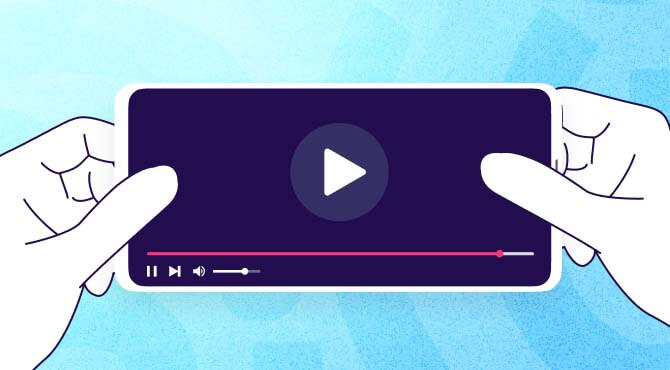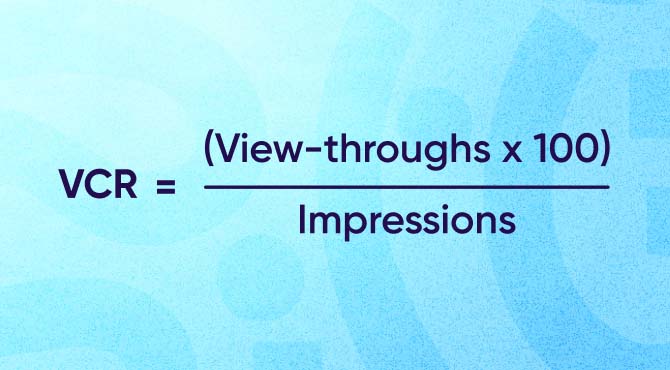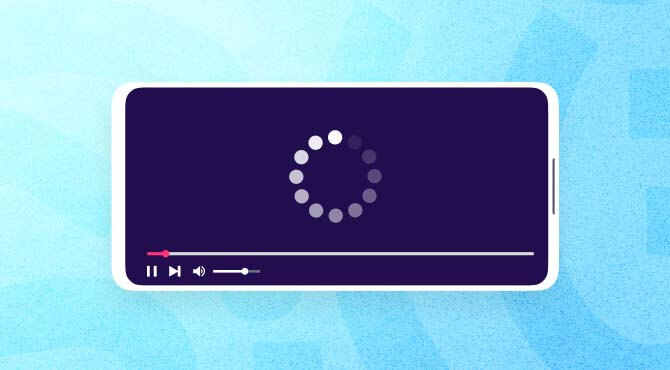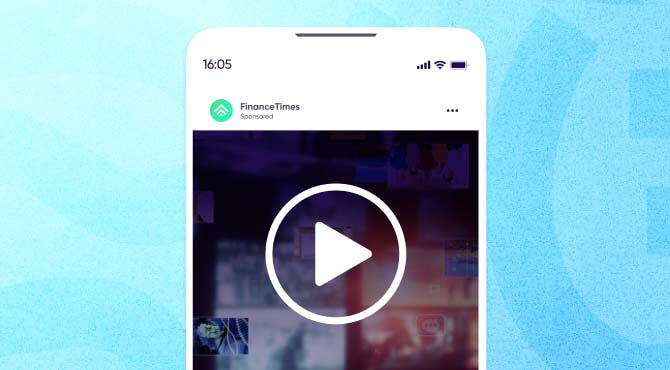What is VCR?
VCR (video completion rate) measures the percentage of viewers who watch an online video to the end, or to a predetermined point.
Try searching for
Your video completion rate (VCR) is the percentage of viewers who watch your online video to the end (or to a predetermined point). It indicates how engaging viewers find your video ads and content.

In video marketing campaigns, video completion rate (VCR) shows the percentage of viewers who watch your video through to the end. Some companies set a different completion point, for instance 95% or 75% of the video.
VCR is important as it measures how engaging a video is. You’ve probably started to play a video before, then closed it after just a few seconds or minutes. Perhaps the content didn’t address what you were looking for, you didn’t like the style, or you realized it was much longer than you wanted to watch.
VCR doesn’t tell you everything about a video (for example, when viewers are dropping off or how they’re engaging), but it does give a helpful snapshot of whether the content holds people’s interest.
Calculating VCR is relatively simple. While some platforms calculate it for you in their metrics, with others you’ll have to pull your view-throughs and impressions to compute it yourself. View-throughs are the completed views, while impressions are the times your video was displayed to a user.
To calculate your VCR, use this simple formula:
VCR = (View-throughs x 100) ÷ Impressions

So, let’s say that your recent video had 1,000 impressions, and 600 of those resulted in completed views. You would calculate this as:
(600 x 100) ÷ 1,000 = 60% VCR
Each video platform uses slightly different terminology for the metrics you need to calculate VCR. Here’s how to find it in three major platforms, and where to find it in their analytics.
VCR = (Video completes x 100) ÷ Video starts

Where to find it: From a computer, sign into YouTube Studio. Click on Analytics on the left-hand menu to find complete views and completion rates. From the YouTube Android app, click on your profile picture, then View channel, then Analytics.
VCR = (Completed video views X 100) ÷ Total video views
Where to find it: Under the TikTok Creator Marketplace, click Campaigns, then Reporting. Point to the campaign you want to analyze for and click the > arrow on the right of your screen.
VCR = Video plays at 100%
Meta also has the ThruPlays, which measure the percentage of videos completed or played for at least 15 minutes.
Where to find it: Log into Ads Manager, click Columns, then Video engagement.
VCR is helpful in understanding viewer behavior, optimizing content, and measuring the success of video marketing campaigns. Let’s take a look at what you can learn and do with VCR.
While video views tell you about potential interest in a video or topic, VCR gives insights into how engaging the content is. A high VCR indicates that the video kept your audience’s interest, while a low VCR may suggest that the content isn’t resonating.
By analyzing VCR, marketers and content creators can identify which videos performed well and which didn’t. With this data, you can make data-driven decisions to optimize your video content, such as adjusting the video’s length, structure, or quality, to improve viewer retention and engagement.

Social media platforms take engagement metrics like completion rates into account when they serve up organic videos to people’s feeds. The better your engagement metrics are, the more feeds you’re likely to reach.
Advertisers often place important information at the end of a video — a CTA, for instance, or link for conversions. Creators who host mid-roll or post-roll in-stream ads need a high completion rate to gain as many impressions and click-throughs as possible.
If you’re an advertiser, VCR is a vital metric to gauge the performance of your video ad campaigns. It helps you understand whether your messaging and creative content are compelling enough to keep viewers watching to the end. With this information, you can refine your targeting, messaging, and placement strategies to enhance your campaign performance.

VCR is a powerful metric, but it doesn’t tell the full story of how a video ad’s performing. Keep the following limitations in mind as you use the metric:
Comparing one campaign’s VCR with another is a bit like comparing apples and oranges. You need to keep the context in mind when analyzing a video’s completion rate.
Data from Wistia’s State of Video shows that the longer a video is, the lower the engagement rate and the lower the average time watched. That means that fewer people complete longer videos. For videos over 60 minutes, the average time watched was just 16:40 – meaning it’s likely only a small percentage of people watched to the end.

Video tools have evolved — it’s easier than ever to make good videos without expensive production equipment and professional videographers. There’s no excuse to use low-quality videos in your content campaigns. Even on a small budget, you can leverage good storytelling and authenticity to shoot high-quality videos from a phone with an external mic.
Slow load times can frustrate viewers, leading them to abandon the video before it starts. Optimizing video delivery through techniques like adaptive streaming protocols and using content delivery networks (CDNs) can help reduce load times and improve completion rates.
Different formats work better for different platforms. A 30-minute podcast interview video may do well on YouTube or LinkedIn, but it won’t do as well on Facebook or TikTok where users look for fast, entertaining clips. Create different cuts of your content for each platform, or consider different content altogether.
When analyzing VCR, it’s important to keep the video ad format in mind when evaluating the metrics.
Viewers must watch non-skippable ads in full before they can access the main content. Because they can’t be skipped, you’ll typically see a higher completion rate and higher message retention and brand recall. However, they may lead to user frustration due to the constraints.
In-banner ads appear in a pre-defined ad space on a website, such as a banner. They can be effective for capturing attention quickly as users browse a webpage, but their impact may be limited by their size and lack of connection to the main content.
Out-stream ads play outside of traditional video players, often embedded within text content or social media feeds. Many start by autoplay, drawing viewers in and reaching a broad audience. While they’re less intrusive than in-stream ads, they may be skipped by users who scroll past quickly or use ad blockers.

In-feed ads appear in social media feeds and are designed to blend seamlessly with organic content, making them less disruptive. They can achieve high engagement rates due to their native placement, but their performance heavily depends on the relevance and quality of the content.
Story ads are full-screen video ads appearing within story features on platforms like Instagram and Snapchat. They’re typically short and designed to be immersive, making use of the vertical format. These can be highly engaging due to their interactive elements and the personal storytelling format. However, the impact can vary based on the platform’s user base and the ad’s creative execution.
VCR is a valuable learning metric. It can help you flag underperforming videos and optimize them. Follow these six tips to create engaging videos your viewers will want to watch till the last second.
Shorter videos generally keep viewers’ attention better. That’s especially true of younger generations, whose attention span averages just eight seconds. However, you need to balance length with the message you want to convey. Experiment with different video lengths to find the optimal duration for your audience.

It’s smart to optimize your content for each type of device users may watch on, from mobile to desktop to CTV. Mobile users may look for a different format, like portrait over landscape, and may prefer shorter video lengths. When designing a video for CTV, consider the platform and context.
Of course, the biggest factor impacting your VCR is the content itself. Research topics your audience is most interested in, leverage emotion and storytelling, and integrate high-quality visuals to boost your videos’ appeal.
Design visually appealing thumbnails and compelling titles that accurately represent the video content. This can increase click-through rates and set clear expectations for viewers.
Most viewers don’t just want to watch a talking head or text on a slide. Use visuals like B roll, data visualization, and text on screen to engage viewers and boost recall. Captions are a powerful way to draw viewers in, especially when videos are played sound-off.
Fine-tune your targeting to match your content with the right audience. Understand your audience’s preferences and interests so you can tailor content that resonates with them, increasing completion rates.
VCR (video completion rate) measures the percentage of viewers who watch an online video to the end, or to a predetermined point.
To measure VCR, use this formula: VCR = (View-throughs x 100) ÷ Impressions.
VCR indicates how engaging viewers find your video content. This helps you understand viewer behavior, optimize content, and measure campaign success.
You can improve your VCR by optimizing underperforming videos for length, format, and device, and creating compelling content for a carefully targeted audience.